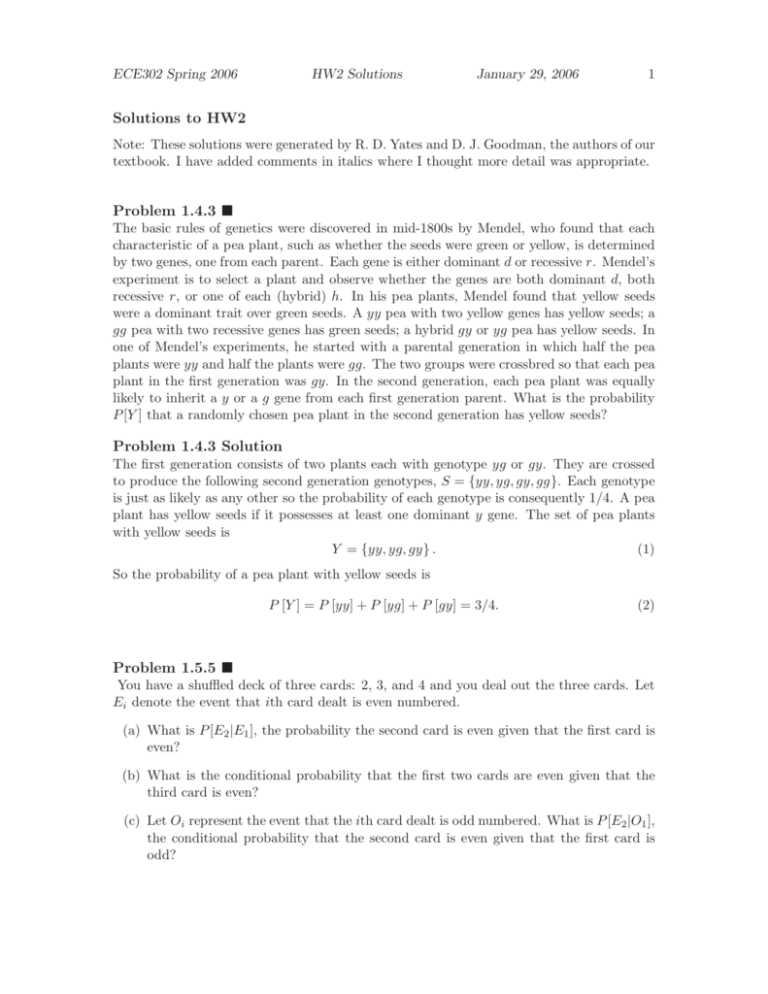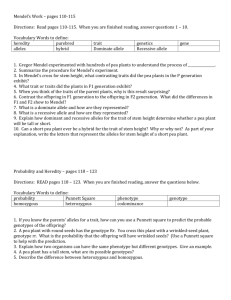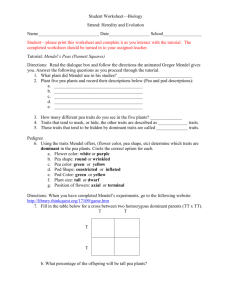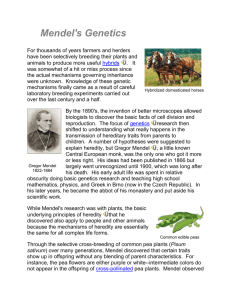HW2 Solution
advertisement

ECE302 Spring 2006
HW2 Solutions
January 29, 2006
1
Solutions to HW2
Note: These solutions were generated by R. D. Yates and D. J. Goodman, the authors of our
textbook. I have added comments in italics where I thought more detail was appropriate.
Problem 1.4.3 The basic rules of genetics were discovered in mid-1800s by Mendel, who found that each
characteristic of a pea plant, such as whether the seeds were green or yellow, is determined
by two genes, one from each parent. Each gene is either dominant d or recessive r. Mendel’s
experiment is to select a plant and observe whether the genes are both dominant d, both
recessive r, or one of each (hybrid) h. In his pea plants, Mendel found that yellow seeds
were a dominant trait over green seeds. A yy pea with two yellow genes has yellow seeds; a
gg pea with two recessive genes has green seeds; a hybrid gy or yg pea has yellow seeds. In
one of Mendel’s experiments, he started with a parental generation in which half the pea
plants were yy and half the plants were gg. The two groups were crossbred so that each pea
plant in the first generation was gy. In the second generation, each pea plant was equally
likely to inherit a y or a g gene from each first generation parent. What is the probability
P [Y ] that a randomly chosen pea plant in the second generation has yellow seeds?
Problem 1.4.3 Solution
The first generation consists of two plants each with genotype yg or gy. They are crossed
to produce the following second generation genotypes, S = {yy, yg, gy, gg}. Each genotype
is just as likely as any other so the probability of each genotype is consequently 1/4. A pea
plant has yellow seeds if it possesses at least one dominant y gene. The set of pea plants
with yellow seeds is
Y = {yy, yg, gy} .
(1)
So the probability of a pea plant with yellow seeds is
P [Y ] = P [yy] + P [yg] + P [gy] = 3/4.
(2)
Problem 1.5.5 You have a shuffled deck of three cards: 2, 3, and 4 and you deal out the three cards. Let
Ei denote the event that ith card dealt is even numbered.
(a) What is P [E2 |E1 ], the probability the second card is even given that the first card is
even?
(b) What is the conditional probability that the first two cards are even given that the
third card is even?
(c) Let Oi represent the event that the ith card dealt is odd numbered. What is P [E2 |O1 ],
the conditional probability that the second card is even given that the first card is
odd?
ECE302 Spring 2006
HW2 Solutions
January 29, 2006
2
(d) What is the conditional probability that the second card is odd given that the first
card is odd?
Problem 1.5.5 Solution
The sample outcomes can be written ijk where the first card drawn is i, the second is j
and the third is k. The sample space is
S = {234, 243, 324, 342, 423, 432} .
(1)
and each of the six outcomes has probability 1/6. The events E1 , E2 , E3 , O1 , O2 , O3 are
E1 = {234, 243, 423, 432} ,
O1 = {324, 342} ,
(2)
E2 = {243, 324, 342, 423} ,
O2 = {234, 432} ,
(3)
E3 = {234, 324, 342, 432} ,
O3 = {243, 423} .
(4)
(a) The conditional probability the second card is even given that the first card is even is
P [E2 |E1 ] =
P [243, 423]
2/6
P [E2 E1 ]
=
=
= 1/2.
P [E1 ]
P [234, 243, 423, 432]
4/6
(5)
(b) The probability the first two cards are even given the third card is even is
P [E1 E2 |E3 ] =
P [E1 E2 E3 ]
= 0.
P [E3 ]
(6)
(c) The conditional probabilities the second card is even given that the first card is odd
is
P [O1 E2 ]
P [O1 ]
P [E2 |O1 ] =
=
= 1.
(7)
P [O1 ]
P [O1 ]
(d) The conditional probability the second card is odd given that the first card is odd is
P [O2 |O1 ] =
P [O1 O2 ]
= 0.
P [O1 ]
(8)
Problem 1.5.6 Deer ticks can carry both Lyme disease and human granulocytic ehrlichiosis (HGE). In a
study of ticks in the Midwest, it was found that 16% carried Lyme disease, 10% had HGE,
and that 10% of the ticks that had either Lyme disease or HGE carried both diseases.
(a) What is the probability P [LH] that a tick carries both Lyme disease (L) and HGE
(H)?
(b) What is the conditional probability that a tick has HGE given that it has Lyme
disease?
ECE302 Spring 2006
HW2 Solutions
3
January 29, 2006
Problem 1.5.6 Solution
The problem statement yields the obvious facts that P [L] = 0.16 and P [H] = 0.10. The
words “10% of the ticks that had either Lyme disease or HGE carried both diseases” can
be written as
P [LH|L ∪ H] = 0.10.
(1)
(a) Since LH ⊂ L ∪ H,
P [LH|L ∪ H] =
P [LH ∩ (L ∪ H)]
P [LH]
=
= 0.10.
P [L ∪ H]
P [L ∪ H]
(2)
Thus,
P [LH] = 0.10P [L ∪ H] = 0.10 (P [L] + P [H] − P [LH]) .
(3)
Since P [L] = 0.16 and P [H] = 0.10,
P [LH] =
0.10 (0.16 + 0.10)
= 0.0236.
1.1
(4)
(b) The conditional probability that a tick has HGE given that it has Lyme disease is
P [H|L] =
P [LH]
0.0236
=
= 0.1475.
P [L]
0.16
(5)
Problem 1.6.3 In an experiment, A, B, C, and D are events with probabilities P [A] = 1/4, P [B] = 1/8,
P [C] = 5/8, and P [D] = 3/8. Furthermore, A and B are disjoint, while C and D are
independent.
(a) Find P [A ∩ B], P [A ∪ B], P [A ∩ B c ], and P [A ∪ B c ].
(b) Are A and B independent?
(c) Find P [C ∩ D], P [C ∩ D c ], and P [C c ∩ D c ].
(d) Are C c and D c independent?
Problem 1.6.3 Solution
(a) Since A and B are disjoint, P [A ∩ B] = 0. Since P [A ∩ B] = 0,
P [A ∪ B] = P [A] + P [B] − P [A ∩ B] = 3/8.
(1)
A Venn diagram should convince you that A ⊂ B c so that A ∩ B c = A. This implies
P [A ∩ B c ] = P [A] = 1/4.
It also follows that P [A ∪ B c ] = P [B c ] = 1 − 1/8 = 7/8.
(2)
ECE302 Spring 2006
HW2 Solutions
January 29, 2006
4
(b) Events A and B are dependent since P [AB] 6= P [A]P [B].
(c) Since C and D are independent,
P [C ∩ D] = P [C] P [D] = 15/64.
(3)
The next few items are a little trickier. From Venn diagrams, we see
P [C ∩ D c ] = P [C] − P [C ∩ D] = 5/8 − 15/64 = 25/64.
(4)
It follows that
P [C ∪ D c ] = P [C] + P [D c ] − P [C ∩ D c ]
= 5/8 + (1 − 3/8) − 25/64 = 55/64.
Using DeMorgan’s law, we have
3
5
c
c
P [C ∩ D ] =
= 15/64 = 1 − P [C ∪ D] = P [(C ∪ D)c ] .
8
8
(5)
(6)
(7)
(d) Since P [C c Dc ] = P [C c ]P [D c ], C c and D c are independent.
Problem 1.6.4 In an experiment, A, B, C, and D are events with probabilities P [A ∪ B] = 5/8, P [A] = 3/8,
P [C ∩ D] = 1/3, and P [C] = 1/2. Furthermore, A and B are disjoint, while C and D are
independent.
(a) Find P [A ∩ B], P [B], P [A ∩ B c ], and P [A ∪ B c ].
(b) Are A and B independent?
(c) Find P [D], P [C ∩ D c ], P [C c ∩ D c ], and P [C|D].
(d) Find P [C ∪ D] and P [C ∪ D c ].
(e) Are C and D c independent?
Problem 1.6.4 Solution
(a) Since A ∩ B = ∅, P [A ∩ B] = 0. To find P [B], we can write
P [A ∪ B] = P [A] + P [B] − P [A ∩ B]
5/8 = 3/8 + P [B] − 0.
(1)
(2)
Thus, P [B] = 1/4. Since A is a subset of B c , P [A ∩ B c ] = P [A] = 3/8. Furthermore,
since A is a subset of B c , P [A ∪ B c ] = P [B c ] = 3/4.
ECE302 Spring 2006
HW2 Solutions
January 29, 2006
5
(b) The events A and B are dependent because
P [AB] = 0 6= 3/32 = P [A] P [B] .
(3)
(c) Since C and D are independent P [CD] = P [C]P [D]. So
P [D] =
P [CD]
1/3
=
= 2/3.
P [C]
1/2
(4)
In addition, P [C ∩ D c ] = P [C] − P [C ∩ D] = 1/2 − 1/3 = 1/6. To find P [C c ∩ D c ],
we first observe that
P [C ∪ D] = P [C] + P [D] − P [C ∩ D] = 1/2 + 2/3 − 1/3 = 5/6.
(5)
By De Morgan’s Law, C c ∩ D c = (C ∪ D)c . This implies
P [C c ∩ D c ] = P [(C ∪ D)c ] = 1 − P [C ∪ D] = 1/6.
(6)
Note that a second way to find P [C c ∩ D c ] is to use the fact that if C and D are
independent, then C c and D c are independent. Thus
P [C c ∩ D c ] = P [C c ] P [D c ] = (1 − P [C])(1 − P [D]) = 1/6.
(7)
Finally, since C and D are independent events, P [C|D] = P [C] = 1/2.
(d) Note that we found P [C ∪ D] = 5/6. We can also use the earlier results to show
P [C ∪ D c ] = P [C] + P [D] − P [C ∩ D c ] = 1/2 + (1 − 2/3) − 1/6 = 2/3.
(8)
(e) By Definition 1.7, events C and D c are independent because
P [C ∩ D c ] = 1/6 = (1/2)(1/3) = P [C] P [D c ] .
(9)
Problem 1.6.5 In an experiment with equiprobable outcomes, the event space (I would have said “the
sample space”) is S = {1, 2, 3, 4} and P [s] = 1/4 for all s ∈ S. Find three events in S that
are pairwise independent but are not independent. (Note: Pairwise independent events
meet the first three conditions of Definition 1.8).
Problem 1.6.5 Solution
For a sample space S = {1, 2, 3, 4} with equiprobable outcomes, consider the events
A1 = {1, 2}
A2 = {2, 3}
A3 = {3, 1} .
(1)
Each event Ai has probability 1/2. Moreover, each pair of events is independent since
P [A1 A2 ] = P [A2 A3 ] = P [A3 A1 ] = 1/4.
(2)
However, the three events A1 , A2 , A3 are not independent since
P [A1 A2 A3 ] = 0 6= P [A1 ] P [A2 ] P [A3 ] .
(3)
ECE302 Spring 2006
HW2 Solutions
January 29, 2006
6
Problem 1.6.6 (Continuation of Problem 1.4.3) One of Mendel’s most significant results was the conclusion that genes determining different characteristics are transmitted independently. In pea
plants, Mendel found that round peas are a dominant trait over wrinkled peas. Mendel
crossbred a group of (rr, yy) peas with a group of (ww, gg) peas. In this notation, rr denotes a pea with two “round” genes and ww denotes a pea with two “wrinkled” genes. The
first generation were either (rw, yg), (rw, gy), (wr, yg), or (wr, gy) plants with both hybrid
shape and hybrid color. Breeding among the first generation yielded second-generation
plants in which genes for each characteristic were equally likely to be either dominant or recessive. What is the probability P [Y ] that a second-generation pea plant has yellow seeds?
What is the probability P [R] that a second-generation plant has round peas? Are R and Y
independent events? How many visibly different kinds of pea plants would Mendel observe
in the second generation? What are the probabilities of each of these kinds?
Problem 1.6.6 Solution
There are 16 distinct equally likely outcomes for the second generation of pea plants based
on a first generation of {rwyg, rwgy, wryg, wrgy}. They are listed below
rryy
rwyy
wryy
wwyy
rryg
rwyg
wryg
wwyg
rrgy
rwgy
wrgy
wwgy
rrgg
rwgg
wrgg
wwgg
(1)
A plant has yellow seeds, that is event Y occurs, if a plant has at least one dominant y gene.
Except for the four outcomes with a pair of recessive g genes, the remaining 12 outcomes
have yellow seeds. From the above, we see that
P [Y ] = 12/16 = 3/4
(2)
P [R] = 12/16 = 3/4.
(3)
and
To find the conditional probabilities P [R|Y ] and P [Y |R], we first must find P [RY ]. Note
that RY , the event that a plant has rounded yellow seeds, is the set of outcomes
RY = {rryy, rryg, rrgy, rwyy, rwyg, rwgy, wryy, wryg, wrgy} .
(4)
Since P [RY ] = 9/16,
P [Y |R ] =
P [RY ]
9/16
=
= 3/4
P [R]
3/4
(5)
and
P [RY ]
9/16
=
= 3/4.
(6)
P [Y ]
3/4
Thus P [R|Y ] = P [R] and P [Y |R] = P [Y ] and R and Y are independent events. There are
four visibly different pea plants, corresponding to whether the peas are round (R) or not
(Rc ), or yellow (Y ) or not (Y c ). These four visible events have probabilities
P [R |Y ] =
P [RY ] = 9/16
c
P [R Y ] = 3/16
P [RY c ] = 3/16,
c
c
P [R Y ] = 1/16.
(7)
(8)
ECE302 Spring 2006
HW2 Solutions
January 29, 2006
7
Problem 1.7.10 Each time a fisherman casts his line, a fish is caught with probability p, independent of
whether a fish is caught on any other cast of the line. The fisherman will fish all day until
a fish is caught and then he will quit and go home. Let Ci denote the event that on cast i
the fisherman catches a fish. Draw the tree for this experiment and find P [C1 ], P [C2 ], and
P [Cn ].
Problem 1.7.10 Solution
The experiment ends as soon as a fish is caught. The tree resembles
p C1
p C2
p C3
C1c C2c C3c
1−p
1−p
1−p
...
From the tree, P [C1 ] = p and P [C2 ] = (1 − p)p. Finally, a fish is caught on the nth cast if
no fish were caught on the previous n − 1 casts. Thus,
P [Cn ] = (1 − p)n−1 p.
(1)
Problem 1.9.1 •
Consider a binary code with 5 bits (0 or 1) in each code word. An example of a code word
is 01010. In each code word, a bit is a zero with probability 0.8, independent of any other
bit.
(a) What is the probability of the code word 00111?
(b) What is the probability that a code word contains exactly three ones?
Problem 1.9.1 Solution
(a) Since the probability of a zero is 0.8, we can express the probability of the code word
00111 as 2 occurrences of a 0 and three occurrences of a 1. Therefore
P [00111] = (0.8)2 (0.2)3 = 0.00512.
(b) The probability that a code word has exactly three 1’s is
5
P [three 1’s] =
(0.8)2 (0.2)3 = 0.0512.
3
(1)
(2)
ECE302 Spring 2006
HW2 Solutions
January 29, 2006
8
Problem 1.9.3 •
Suppose each day that you drive to work a traffic light that you encounter is either green
with probability 7/16, red with probability 7/16, or yellow with probability 1/8, independent
of the status of the light on any other day. If over the course of five days, G, Y , and R
denote the number of times the light is found to be green, yellow, or red, respectively, what
is the probability that P [G = 2, Y = 1, R = 2]? Also, what is the probability P [G = R]?
Problem 1.9.3 Solution
We know that the probability of a green and red light is 7/16, and that of a yellow light is
1/8. Since there are always 5 lights, G, Y , and R obey the multinomial probability law:
2 2
5!
7
1
7
.
(1)
P [G = 2, Y = 1, R = 2] =
2!1!2! 16
8
16
The probability that the number of green lights equals the number of red lights
P [G = R] = P [G = 1, R = 1, Y = 3] + P [G = 2, R = 2, Y = 1] + P [G = 0, R = 0, Y = 5]
(2)
=
5!
1!1!3!
7
16
3
2 2 5
5!
7
1
7
7
1
1
5!
+
+
16
8
2!1!2! 16
16
8
0!0!5! 8
≈ 0.1449.
(3)
(4)
Problem 1.10.2 We wish to modify the cellular telephone coding system in Example 1.41 in order to reduce
the number of errors. In particular, if there are two or three zeroes in the received sequence
of 5 bits, we will say that a deletion (event D) occurs. Otherwise, if at least 4 zeroes are
received, then the receiver decides a zero was sent. Similarly, if at least 4 ones are received,
then the receiver decides a one was sent. We say that an error occurs if either a one was
sent and the receiver decides zero was sent or if a zero was sent and the receiver decides a
one was sent. For this modified protocol, what is the probability P [E] of an error? What
is the probability P [D] of a deletion?
Problem 1.10.2 Solution
Suppose that the transmitted bit was a 1. We can view each repeated transmission as an
independent trial. We call each repeated bit the receiver decodes as 1 a success. Using Sk,5
to denote the event of k successes in the five trials, then the probability k 1’s are decoded
at the receiver is
5 k
P [Sk,5 ] =
p (1 − p)5−k , k = 0, 1, . . . , 5.
(1)
k
The probability that [the transmitted] bit is decoded correctly is
P [C] = P [S5,5 ] + P [S4,5 ] = p5 + 5p4 (1 − p) = 0.91854.
(2)
January 29, 2006
9
P [D] = P [S3,5 ] + P [S2,5 ] = 10p3 (1 − p)2 + 10p2 (1 − p)3 = 0.081.
(3)
ECE302 Spring 2006
HW2 Solutions
The probability a deletion occurs is
The probability of an error is
P [E] = P [S1,5 ] + P [S0,5 ] = 5p(1 − p)4 + (1 − p)5 = 0.00046.
(4)
Note that if a 0 is transmitted, then 0 is sent five times and we call decoding a 0 a success.
You should convince yourself that this a symmetric situation with the same deletion and
error probabilities. Introducing deletions reduces the probability of an error by roughly a
factor of 20. However, the probability of successful decoding is also reduced.
Problem 1.10.3 Suppose a 10-digit phone number is transmitted by a cellular phone using four binary
symbols for each digit, using the model of binary symbol errors and deletions given in
Problem 1.10.2. If C denotes the number of bits sent correctly, D the number of deletions,
and E the number of errors, what is P [C = c, D = d, E = e]? Your answer should be correct
for any choice of c, d, and e.
Problem 1.10.3 Solution
Note that each digit 0 through 9 is mapped to the 4 bit binary representation of the digit.
That is, 0 corresponds to 0000, 1 to 0001, up to 9 which corresponds to 1001. Of course,
the 4 bit binary numbers corresponding to numbers 10 through 15 go unused, however this
is unimportant to our problem. the 10 digit number results in the transmission of 40 bits.
For each bit, an independent trial determines whether the bit was correct, a deletion, or an
error. In Problem 1.10.2, we found the probabilities of these events to be
P [C] = γ = 0.91854,
P [D] = δ = 0.081,
P [E] = ǫ = 0.00046.
(1)
Since each of the 40 bit transmissions is an independent trial, the joint probability of c
correct bits, d deletions, and e erasures has the multinomial probability
40! c d e
c + d + e = 40; c, d, e ≥ 0,
c!d!e! γ δ ǫ
(2)
P [C = c, D = d, E = d] =
0
otherwise.
Problem 1.11.2 Build a Matlab simulation of 50 trials of the experiment of Example 1.27. Your output
should be a pair of 50 × 1 vectors C and H. For the ith trial, Hi will record whether it was
heads (Hi = 1) or tails (Hi = 0), and Ci ∈ {1, 2} will record which coin was picked.
Problem 1.11.2 Solution
Rather than just solve the problem for 50 trials, we can write a function that generates
vectors C and H for an arbitrary number of trials n. The code for this task is
ECE302 Spring 2006
HW2 Solutions
January 29, 2006
10
function [C,H]=twocoin(n);
C=ceil(2*rand(n,1));
P=1-(C/4);
H=(rand(n,1)< P);
The first line produces the n×1 vector C such that C(i) indicates whether coin 1 or coin 2 is
chosen for trial i. Next, we generate the vector P such that P(i)=0.75 if C(i)=1; otherwise,
if C(i)=2, then P(i)=0.5. As a result, H(i) is the simulated result of a coin flip with heads,
corresponding to H(i)=1, occurring with probability P(i).
Problem 1.11.3 Following Quiz 1.9, suppose the communication link has different error probabilities for
transmitting 0 and 1. When a 1 is sent, it is received as a 0 with probability 0.01. When
a 0 is sent, it is received as a 1 with probability 0.03. Each bit in a packet is still equally
likely to be a 0 or 1. Packets have been coded such that if five or fewer bits are received
in error, then the packet can be decoded. Simulate the transmission of 100 packets, each
containing 100 bits. Count the number of packets decoded correctly.
Problem 1.11.3 Solution
Rather than just solve the problem for 100 trials, we can write a function that generates n
packets for an arbitrary number of trials n. The code for this task is
function C=bit100(n);
% n is the number of 100 bit packets sent
B=floor(2*rand(n,100));
P=0.03-0.02*B;
E=(rand(n,100)< P);
C=sum((sum(E,2)<=5));
First, B is an n × 100 matrix such that B(i,j) indicates whether bit i of packet j is zero or
one. Next, we generate the n × 100 matrix P such that P(i,j)=0.03 if B(i,j)=0; otherwise,
if B(i,j)=1, then P(i,j)=0.01. As a result, E(i,j) is the simulated error indicator for
bit i of packet j. That is, E(i,j)=1 if bit i of packet j is in error; otherwise E(i,j)=0.
Next we sum across the rows of E to obtain the number of errors in each packet. Finally,
we count the number of packets with 5 or more errors.
For n = 100 packets, the packet success probability is inconclusive. Experimentation
will show that C=97, C=98, C=99 and C=100 correct packets are typical values that might
be observed. By increasing n, more consistent results are obtained. For example, repeated
trials with n = 100, 000 packets typically produces around C = 98, 400 correct packets. Thus
0.984 is a reasonable estimate for the probability of a packet being transmitted correctly.







